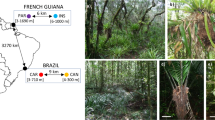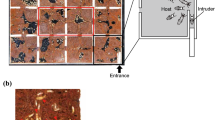Abstract
Five possible mechanisms might underlie kin recognition in social groups: spatial location, familiarity through prior association, phenotype matching, recognition alleles, or rejecting unfamiliar cues. Kin recognition by phenotype matching relies on a strong correlation between genotype and phenotype. Aggression bioassays are the standard method for investigating recognition in animals, particularly social insect interactions among nestmates and non-nestmates. These bioassays typically pay little regard to how outcomes are determined by differences in chemical recognition cues of the test subjects, because the system of signal coding was unknown until recently. We exploited the known nestmate recognition system of the ant Formica exsecta to investigate aggression between 24 pairs of colonies across a range of chemical (Z9-alkene & n-alkanes), genetic, and spatial distances. The whole Z9-alkene chemical profile was the only significant (p < 0.001) predictor of aggression levels. Aggression was a nonlinear step function of Z9-alkene chemical distance, where a small change in chemical profile resulted in a rapid behavioural transition from non-aggression to overt aggression. These findings raise questions surrounding our current understanding of recognition systems, because they support phenotype matching to a colony chemical profile without a significant genetic or spatial component.



Similar content being viewed by others
References
Akino T, Yamamura K, Wakamura S, Yamaoka R (2004) Direct behavioural evidence for hydrocarbons as nest mate recognition cues in Formica japonica (Hymenoptera: Formicidae). Appl Entomol Zool 39:381–387
Axelrod R, Hammond RA, Grafen A (2004) Altruism via kin-selection strategies that rely on arbitrary tags with which they co-evolve. Evolution 58:1833–1838
Beecher MD, Beecher IM, Lumpkin S (1981) Parent-offspring recognition in the bank swallows (Riparia riparia): development and acoustic basis. Anim Behav 29:95–101
Blomquist GJ, Bagnères A-G (2010) Insect hydrocarbons; biology, biochemistry and chemical ecology. Cambridge University Press, New York, p 492
Boomsma JJ, Nielsen J, Sundström L, Oldham NJ, Tentschert J, Petersen HC, Morgan ED (2003) Informational constraints on optimal sex allocation in ants. Proc Nat Acad Sci 100:8799–8804
Châline N, Sandoz JC, Martin SJ, Ratnieks FLW, Jones GR (2005) Learning and discrimination of individual cuticular hydrocarbons by honey bees (Apis mellifera). Chem Senses 30:327–333
Chapuisat M (1996) Characterization of microsatellite loci in Formica lugubris and their variability in other ant species. Mol Ecol 5:599–601
Couvillon MJ, Ratnieks FLW (2008) Odour transfer in stingless bee marmelada (Frieseomelitta varia) demonstrates that entrance guards use an “undesirable-absent” recognition system. Behav Ecol Sociobiol 62:1099–1105
Crozier RH (1986) Genetic clonal recognition abilities in marine invertebrates must be maintained by selection for something else. Evolution 40:1100–1101
Dani FR, Jones GR, Corsi S, Beard R, Pradella D, Turillazi S (2005) Nest mate recognition cues in the honey bee: differential importance of cuticular alkanes and alkenes. Chem Senses 30:1–13
Errard C, Hefetz A, Jaisson P (2006) Social discrimination tuning in ants: template formation and chemical similarity. Behav Ecol Sociobiol 59:353–363
Getz WM (1981) Genetically based kin recognition systems. J Theor Biol 92:209–226
Goudet J (1995) FSTAT (vers. 1.2): a computer program to calculate F-statistics. J Hered 86:485–486
Goudet J (2001) FSTAT, a program to estimate and test gene diversities and fixation indices (version 2.9.3). (Updated from Goudet 1995). http://www.unil.ch/izea/softwares/fstat.html. Accessed 1 March 2003
Greene MJ, Gordon DM (2007) Structural complexity of chemical recognition cues affects the perception of group membership in the ants Linephithema humile and Aphaenogaster cockerelli. J Exp Biol 210:897–905
Guerrieri FJ, d’Ettorre P (2008) The mandible opening response: quantifying aggression elicited by chemical cues in ants. J Exp Biol 211:1109–1113
Guerrieri FJ, Nehring V, Jørgensen CG, Galizia CG, D’Ettorre P (2009) Ants recognize foes and not friends. Proc Roy Soc B 276:2461–2468
Gyllenstrand N, Gertsch PJ, Pamilo P (2002) Polymorphic microsatellite DNA markers in the ant Formica exsecta. Mol Ecol Notes 2:67–69
Haag-Liautard C, Vitikainen E, Keller L, Sundström L (2009) Fitness and the level of homozygosity in a social insect. J Evol Biol 22:134–142
Hasegawa E, Imai S (2004) Characterization of microsatellite loci in red wood ants Formica (s. str.) spp. and the related genus polyergus. Mol Ecol Notes 4:200–203
Helanterä H, Lee Y, Drijfhout FP, Martin SJ (2011) Genetic diversity, colony chemical phenotype and nestmate recognition in the ant Formica fusca. Behav Ecol 22:710–716
Hölldobler B, Wilson EO (2009) The superorganism: the beauty, elegance, and strangeness of insect societies. WW Norton & Company Ltd, London
Holmes WG (1984) Sibling recognition in thirteen-lined ground squirrels: effects of genetic relatedness, rearing associations, and olfaction. Behav Ecol Sociobiol 14:225–233
Holmes WG (2004) The early history of Hamiltonian-based research on kin recognition. Ann Zool Fennici 41:691–711
Johnson BR, van Wilgenburg E, Tsutsui ND (2011) Nestmate recognition in social insects: overcoming physiological constraints with collective decision making. Behav Ecol Sociobiol 65(5):935–944 (online first)
Keller L, Ross KG (1998) Selfish genes: a green beard in the red fire ant. Nature 394:573–575
Lacy RC, Sherman PW (1983) Kin recognition by phenotype matching. Am Nat 121:489–512
Martin SJ, Drijfhout FP (2009a) How reliable is the analysis of complex cuticular hydrocarbon profiles by multi-variate statistical methods? J Chem Ecol 35:375–382
Martin SJ, Drijfhout FP (2009b) A review of ant cuticular hydrocarbons. J Chem Ecol 35:1151–1161
Martin SJ, Helanterä H, Drijfhout FP (2008a) Colony-specific hydrocarbons identify nest mates in two species of Formica ant. J Chem Ecol 34:1072–1080
Martin SJ, Vitikainen E, Helanterä H, Drijfhout FP (2008b) Chemical basis of nest mate recognition in the ant Formica exsecta. Proc Roy Soc B 275:1271–1278
Martin SJ, Helanterä H, Kiss K, Lee YR, Drijfhout FP (2009) Polygyny reduces rather than increases nest mate discrimination cue diversity in Formica exsecta ants. Insect Soc 56:375–383
Mateo JM (2009) The causal role of odours in the development of recognition templates and social preferences. Anim Behav 77:115–121
Morgan ED (2004) Biosynthesis in insects. Royal Society of Chemistry, Cambridge
Nehring N, Evison SEF, Santorelli LA, d’Ettorre P, Hughes WO (2011) Kin-informative recognition cues in ants. Proc Roy Soc Lond B 278:1942–1948
Newey P (2011) Not one odour but two: a new model for nestmate recognition. J Theor Biol 270:7–12
Ozaki M, Wada-Katsumata A, Fujikawa K, Iwasaki M, Yokohari F et al (2005) Ant nest mate and non-nest mate discrimination by a chemosensory sensillium. Science 309:311–315
Palagi E, Dapporto L (2006) Beyond odor discrimination: demonstrating individual recognition by scent in Lemur catta. Chem Senses 31:437–443
Queller DC, Goodnight KF (1997) Relatedness Version 5.0. Keck center for computation biology. Rice University, Houston
Reeve HK (1989) The evolution of conspecific acceptance thresholds. Am Nat 133:407–435
Roulston TH, Buczkowski G, Silverman J (2003) Nestmate discrimination in ants: effect of bioassay on aggressive behaviour. Insect Soc 50:151–159
Rousset F, Roze D (2007) Constraints on the origin and maintenance of genetic kin recognition. Evolution 61:2320–2330
Schmidt AM, d’Ettorre P, Pedersen JS (2010) Low levels of nestmate discrimination despite high genetic differentiation in the invasive pharaoh ant. Front Zool 7:20
Sherman PW, Reeve HK, Pfennig DW (1997) Recognition systems. In: Krebs JR, Davies NB (eds) Behavioural ecology: an evolutionary apporach. Blackwell Science, Oxford, pp 69–96
Sundström L, Keller L, Chapuisat M (2003) Inbreeding and sex-biased gene flow in the ant Formica exsecta. Evolution 57:1552–1561
Trontti K, Tay WT, Sundström L (2003) Characterisation of polymorphic microsatellite loci for the ant Plagiolepis pygmaea. Mol Ecol Notes 3:575–577
Vitikainen E (2010) Causes and consequences of inbreeding in the ant Formica exsecta. Ph.D. thesis, Faculty of Biosciences, University of Helsinki, Finland
Wagner D, Tissot M, Gordon DM (2001) Task-related environment alters the cuticular hydrocarbon composition of harvester ants. J Chem Ecol 27:1805–1819
Waldman B (1988) The ecology of kin recognition. Ann Rev Ecol Syst 19:543–571
Wyatt TD (2003) Pheromones and animal behaviour: communication by smell andtaste. Cambridge University Press, Cambridge
Acknowledgments
The authors thank Roger Butlin of Sheffield University for comments, and Kalle Trontti, University of Helsinki, funded by Finnish Academy grant 134561 for help in genotyping. The authors also thank Liselotte Sundström of University of Helsinki for comments and help with the Finnish field work funded by Academy of Finland grant (206505, 121216) and providing permission to work on the ant population at the Tvärminne zoological station. This study was funded by NERC grant NE/F018355/1 and NE/F018088/1.
Author information
Authors and Affiliations
Corresponding author
Additional information
Edited by Bambos Kyriacou.
Rights and permissions
About this article
Cite this article
Martin, S.J., Vitikainen, E., Drijfhout, F.P. et al. Conspecific Ant Aggression is Correlated with Chemical Distance, but not with Genetic or Spatial Distance. Behav Genet 42, 323–331 (2012). https://doi.org/10.1007/s10519-011-9503-0
Received:
Accepted:
Published:
Issue Date:
DOI: https://doi.org/10.1007/s10519-011-9503-0




